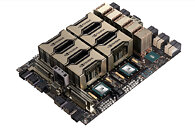
AWS and NVIDIA Extend Collaboration to Advance Generative AI Innovation
Amazon Web Services (AWS), an Amazon.com company, and NVIDIA today announced that the new NVIDIA Blackwell GPU platform - unveiled by NVIDIA at GTC 2024 - is coming to AWS. AWS will offer the NVIDIA GB200 Grace Blackwell Superchip and B100 Tensor Core GPUs, extending the companies' long standing strategic collaboration to deliver the most secure and advanced infrastructure, software, and services to help customers unlock new generative artificial intelligence (AI) capabilities.
NVIDIA and AWS continue to bring together the best of their technologies, including NVIDIA's newest multi-node systems featuring the next-generation NVIDIA Blackwell platform and AI software, AWS's Nitro System and AWS Key Management Service (AWS KMS) advanced security, Elastic Fabric Adapter (EFA) petabit scale networking, and Amazon Elastic Compute Cloud (Amazon EC2) UltraCluster hyper-scale clustering. Together, they deliver the infrastructure and tools that enable customers to build and run real-time inference on multi-trillion parameter large language models (LLMs) faster, at massive scale, and at a lower cost than previous-generation NVIDIA GPUs on Amazon EC2.
NVIDIA and AWS continue to bring together the best of their technologies, including NVIDIA's newest multi-node systems featuring the next-generation NVIDIA Blackwell platform and AI software, AWS's Nitro System and AWS Key Management Service (AWS KMS) advanced security, Elastic Fabric Adapter (EFA) petabit scale networking, and Amazon Elastic Compute Cloud (Amazon EC2) UltraCluster hyper-scale clustering. Together, they deliver the infrastructure and tools that enable customers to build and run real-time inference on multi-trillion parameter large language models (LLMs) faster, at massive scale, and at a lower cost than previous-generation NVIDIA GPUs on Amazon EC2.





































